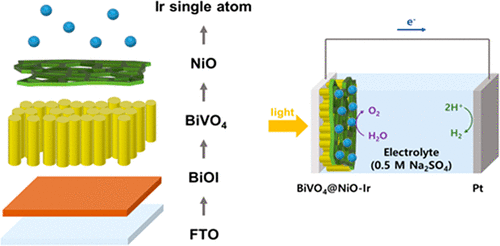当前位置:
X-MOL 学术
›
ACS Appl. Energy Mater.
›
论文详情
Our official English website, www.x-mol.net, welcomes your
feedback! (Note: you will need to create a separate account there.)
Boosting Water Oxidation Performance of BiVO4 Photoanode by Vertically Stacked NiO Nanosheets Coupled with Atomically Dispersed Iridium Sites
ACS Applied Energy Materials ( IF 5.4 ) Pub Date : 2021-09-21 , DOI: 10.1021/acsaem.1c02181 D. Amaranatha Reddy 1 , Yujin Kim 2 , K. Arun Joshi Reddy 2 , Madhusudana Gopannagari 2 , A. Putta Rangappa 2 , D. Praveen Kumar 2 , A. Aravindh Sasikala Devi 3 , Devaraj Murali 1 , Hyun S. Ahn 2 , Tae Kyu Kim 2
ACS Applied Energy Materials ( IF 5.4 ) Pub Date : 2021-09-21 , DOI: 10.1021/acsaem.1c02181 D. Amaranatha Reddy 1 , Yujin Kim 2 , K. Arun Joshi Reddy 2 , Madhusudana Gopannagari 2 , A. Putta Rangappa 2 , D. Praveen Kumar 2 , A. Aravindh Sasikala Devi 3 , Devaraj Murali 1 , Hyun S. Ahn 2 , Tae Kyu Kim 2
Affiliation

|
Atomically dispersed oxygen evoution cocatalysts embedded on 2D metal oxide nanosheets are at the heart of the key to solar to chemical energy conversion applications. However, high photocurrent density, conversion efficiency, and durability remain grand challenges due to their photocorrosion in electrolyte solutions. To overcome these challenges, we designed a highly efficient and stable photoanode consisting of vertically stacked NiO nanosheets coupled with atomically dispersed iridium sites on a BiVO4 semiconductor as a water oxidation photoanode. A series of analyses, including scanning tunneling electron microscopy, X-ray spectroscopy, and density functional theory (DFT) calculations, demonstrated that the Ir atoms are atomically dispersed on the surface of vertically stacked NiO sheets with a favorable oxidation state and suitable band edge potentials for charge separation and transport. Owing to these properties, the designed BiVO4@NiO–Ir exhibited a stable water oxidation photocurrent of 4.33 mA·cm–2 at 1.23 V vs a reversible hydrogen electrode (RHE) under simulated solar light, which is much higher compared to those of BiVO4, BiVO4@NiO, and BiVO4@Ir photoanodes. In addition, we observed the evolution of stoichiometric amounts of oxygen and hydrogen with 96% Faradaic efficiency for greater than a 10 h duration. The DFT results showed that the potential determining step (PDS) of the oxygen evolution reaction at the BiVO4@NiO–Ir surface is only 0.68 eV compared to 1.78 eV at the BiVO4@NiO surface. The significant reduction of PDS on the order of 1 eV for BiVO4@NiO–Ir demonstrates superior photoelectrochemical (PEC) performance. We strongly believe that this work aids the design of atomically scaled nanocatalysts for solar-driven chemical fuel device applications.
中文翻译:

通过垂直堆叠的 NiO 纳米片与原子分散的铱位点耦合提高 BiVO4 光阳极的水氧化性能
嵌入在二维金属氧化物纳米片上的原子分散的氧释放助催化剂是太阳能到化学能转换应用的关键。然而,由于它们在电解质溶液中的光腐蚀,高光电流密度、转换效率和耐久性仍然是巨大的挑战。为了克服这些挑战,我们设计了一种高效且稳定的光电阳极,由垂直堆叠的 NiO 纳米片与 BiVO 4上原子分散的铱位点组成半导体作为水氧化光阳极。一系列分析,包括扫描隧道电子显微镜、X 射线光谱和密度泛函理论 (DFT) 计算,表明 Ir 原子原子地分散在垂直堆叠的 NiO 片的表面上,具有良好的氧化态和合适的带边电荷分离和传输的潜力。由于这些特性,设计的 BiVO 4 @NiO-Ir在 1.23 V 下与可逆氢电极 (RHE) 在模拟太阳光下表现出 4.33 mA·cm –2的稳定水氧化光电流,与BiVO 4、BiVO 4 @NiO 和 BiVO 4@Ir 光阳极。此外,我们观察到在超过 10 小时的持续时间内,以 96% 的法拉第效率释放出化学计量的氧和氢。DFT 结果表明,BiVO 4 @NiO-Ir 表面析氧反应的电位确定步骤(PDS)仅为 0.68 eV,而 BiVO 4 @NiO 表面为 1.78 eV 。BiVO 4 @NiO-Ir的 PDS 显着降低了 1 eV 的数量级,证明了优异的光电化学(PEC)性能。我们坚信这项工作有助于设计用于太阳能驱动化学燃料装置应用的原子级纳米催化剂。
更新日期:2021-10-25
中文翻译:

通过垂直堆叠的 NiO 纳米片与原子分散的铱位点耦合提高 BiVO4 光阳极的水氧化性能
嵌入在二维金属氧化物纳米片上的原子分散的氧释放助催化剂是太阳能到化学能转换应用的关键。然而,由于它们在电解质溶液中的光腐蚀,高光电流密度、转换效率和耐久性仍然是巨大的挑战。为了克服这些挑战,我们设计了一种高效且稳定的光电阳极,由垂直堆叠的 NiO 纳米片与 BiVO 4上原子分散的铱位点组成半导体作为水氧化光阳极。一系列分析,包括扫描隧道电子显微镜、X 射线光谱和密度泛函理论 (DFT) 计算,表明 Ir 原子原子地分散在垂直堆叠的 NiO 片的表面上,具有良好的氧化态和合适的带边电荷分离和传输的潜力。由于这些特性,设计的 BiVO 4 @NiO-Ir在 1.23 V 下与可逆氢电极 (RHE) 在模拟太阳光下表现出 4.33 mA·cm –2的稳定水氧化光电流,与BiVO 4、BiVO 4 @NiO 和 BiVO 4@Ir 光阳极。此外,我们观察到在超过 10 小时的持续时间内,以 96% 的法拉第效率释放出化学计量的氧和氢。DFT 结果表明,BiVO 4 @NiO-Ir 表面析氧反应的电位确定步骤(PDS)仅为 0.68 eV,而 BiVO 4 @NiO 表面为 1.78 eV 。BiVO 4 @NiO-Ir的 PDS 显着降低了 1 eV 的数量级,证明了优异的光电化学(PEC)性能。我们坚信这项工作有助于设计用于太阳能驱动化学燃料装置应用的原子级纳米催化剂。











































 京公网安备 11010802027423号
京公网安备 11010802027423号